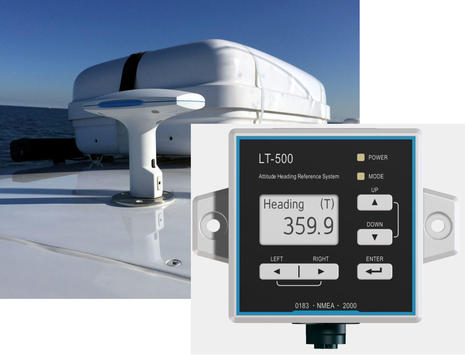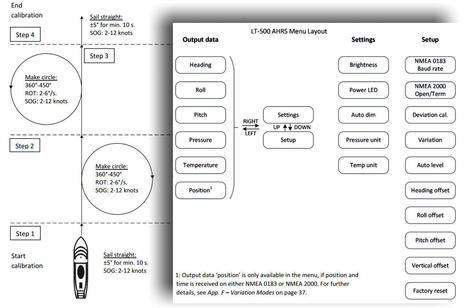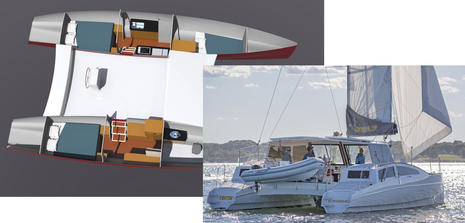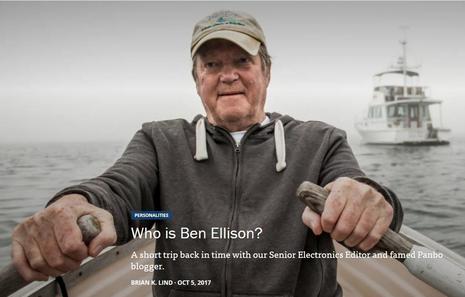New: Lars Thrane sensors, B&G Triton2, and Maine Cat 38
 Today I’ve got a smorgasbord of new gear to share, starting with a trio of serious multi-sensors from Lars Thrane A/S in Denmark. The company first came to my attention when they inquired about advertising — thanks, LT — but a little research revealed why their products may well appeal to Panbo readers. The LT-500 AHRS in the foreground is an 11-sensor Heading, Roll, Pitch, Air Pressure and Temperature device; the LT-300 GNSS not shown is a 72-channel GPS/GLONASS/BeiDou receiver; and the LT-1000 Navigation Reference Unit (NRU) shown installed essentially combines the two. Common to all of the current Lars Thrane products is promised high precision, reasonable pricing, simultaneous NMEA 0183 and 2000 output, and an impressive attention to the real boat details involved in installation, calibration, and future proofing…
Today I’ve got a smorgasbord of new gear to share, starting with a trio of serious multi-sensors from Lars Thrane A/S in Denmark. The company first came to my attention when they inquired about advertising — thanks, LT — but a little research revealed why their products may well appeal to Panbo readers. The LT-500 AHRS in the foreground is an 11-sensor Heading, Roll, Pitch, Air Pressure and Temperature device; the LT-300 GNSS not shown is a 72-channel GPS/GLONASS/BeiDou receiver; and the LT-1000 Navigation Reference Unit (NRU) shown installed essentially combines the two. Common to all of the current Lars Thrane products is promised high precision, reasonable pricing, simultaneous NMEA 0183 and 2000 output, and an impressive attention to the real boat details involved in installation, calibration, and future proofing…
 For instance, while it’s common for heading devices to offer automated Deviation calibration when you run the boat through a manuever like the one diagrammed at left above, the Lars Thrane version looks particularly easy and the engineers went one smart little step further: Until an LT-500 or an LT-1000 is calibrated the Heading output (True or Magnetic) is limited to 5 degree resolution and thus it should be obvious if you need to do a calibration maneuver and then if you did it correctly.
For instance, while it’s common for heading devices to offer automated Deviation calibration when you run the boat through a manuever like the one diagrammed at left above, the Lars Thrane version looks particularly easy and the engineers went one smart little step further: Until an LT-500 or an LT-1000 is calibrated the Heading output (True or Magnetic) is limited to 5 degree resolution and thus it should be obvious if you need to do a calibration maneuver and then if you did it correctly.
For further configuration, the LT-500 has a button and screen interface — its menu layout shown above right — that’s unique for a compass, I’m pretty sure. The LT-1000 has a simpler interface more appropriate to its usual install location, but, then again, I don’t know of any similar device that lets an installer change NMEA 2000 backbone termination mode and/or NMEA 0183 baud rate with dip switches and also shows status lights. Moreover, all three Lars Thrane products can be configured even deeper and updated using a free PC software tool that communicates to the device via the serial 0183 port.
 The LT Service Tool software is shown at left above, and though it’s almost DOS-like, I’ll bet that some pro installers and/or DIY boaters who’ve struggled with third party electronic compasses will find it beautiful. Airmar and Maretron, for instance, make good combo NMEA 0183/2000 heading devices — a sign of how many boats need both — but I’m not sure that either offers this level of configuration and flexibility, and they definitely need additional hardware like an N2K gateway or display for any manual configuration, let alone firmware updating. That’s why I think that the LT-1000, which comes complete with a 10m cable and a field installable N2K connector, is reasonable at about $850 retail.
The LT Service Tool software is shown at left above, and though it’s almost DOS-like, I’ll bet that some pro installers and/or DIY boaters who’ve struggled with third party electronic compasses will find it beautiful. Airmar and Maretron, for instance, make good combo NMEA 0183/2000 heading devices — a sign of how many boats need both — but I’m not sure that either offers this level of configuration and flexibility, and they definitely need additional hardware like an N2K gateway or display for any manual configuration, let alone firmware updating. That’s why I think that the LT-1000, which comes complete with a 10m cable and a field installable N2K connector, is reasonable at about $850 retail.
While I may get to test an LT-1000 or 500, the specs already look impressive. Static Heading, Roll, and Pitch, for instance, are all claimed accurate to “<0.5°” (with Rate of Turn at “<1°/s” and dynamic Heading at “<1.5°”). And while Lars Thrane A/S is a new and small company, their boast about putting 40 years of experience into their products seems fully justified. In fact, the company could be called Thrane, Thrane & Thrane, and this profile of the patriarch suggests significant ambitions, as does their partnership with Iridium.
B&G Triton2
 I might have noted that while sensor specialists like Lars Thrane have much to offer, I think, they are also challenged by the big brands that can integrate what are often middling sensors with very sexy screens. But B&G made that point well when the Triton2 Instrument suddenly appeared online this morning. It’s not really a surprise as the hardware seems the same as the Simrad IS42, but B&G has added attractive SailSteer, Wind Plot, and AP-by-wind-angle screens (and maybe more). This video shows them well.
I might have noted that while sensor specialists like Lars Thrane have much to offer, I think, they are also challenged by the big brands that can integrate what are often middling sensors with very sexy screens. But B&G made that point well when the Triton2 Instrument suddenly appeared online this morning. It’s not really a surprise as the hardware seems the same as the Simrad IS42, but B&G has added attractive SailSteer, Wind Plot, and AP-by-wind-angle screens (and maybe more). This video shows them well.
The Triton2 can be paired with the Triton2 Autopilot Controller (like the Simrad OP12), and thus you get the bright, clean, low-profile glass bridge look in a full AP head that’s usefully divided into two parts. I’ve been long testing the original Triton and AP keypad for years now, and while all the majors now have good remotes that usually include some AP control, I think there should be more dedicated autopilot pads like this.
 It’s interesting that B&G calls out NMEA 2000 certification as a T2 feature, and the point is evident in this system wiring example from the install manual. The orginal Triton gear on Gizmo is working fine with SimNet to Micro-C adaptor cables but now Micro-C — also known as DeviceNet, and the N2K standard — is everywhere, apparently including the Triton2 sensors. That’s good news — the alternate N2K cabling schemes caused confusion — but the Triton2 also lacks a second port for daisychaining, which might make fitting several into a tight pod harder. I’m not sure that the NMEA should have prevailed in that regard (as discussed here).
It’s interesting that B&G calls out NMEA 2000 certification as a T2 feature, and the point is evident in this system wiring example from the install manual. The orginal Triton gear on Gizmo is working fine with SimNet to Micro-C adaptor cables but now Micro-C — also known as DeviceNet, and the N2K standard — is everywhere, apparently including the Triton2 sensors. That’s good news — the alternate N2K cabling schemes caused confusion — but the Triton2 also lacks a second port for daisychaining, which might make fitting several into a tight pod harder. I’m not sure that the NMEA should have prevailed in that regard (as discussed here).
It’s also worth noting that in the system above sensor configuration is going to be easy, maybe even graphically slick, via the instrument display. But a firmware update to add new features or fix bugs is going to take a borrowed B&G MFD with an SD card slot, and I believe that’s true of Furuno and Raymarine instrument and autopilot systems as well (unless they too offer something like Garmin’s N2K Updater). {Correction: I learned from reader comments and from B&G that the Triton2 — and the Simrad IS42 — solves this issue neatly with a USB port that allows updates of its firmware as well other B&G devices on the NMEA 2000 network.} That’s more evidence of how clever Lars Thrane’s old school serial connection seems at this point in marine electronics evolution. And while I’m confident that an LT sensor would feed the Triton2 displays well, it can’t update one. The conundrums!
Maine Cat 38
 I spotted the Triton2 amongst the new boats and products vying for a Newport Boat Show award, and I figure that one possible winner is the Maine Cat 38. Admittedly I’m a longtime fan of what is possibly Maine’s most unusual boatbuilder, and almost purchased a P-47 power cat. But I got to see the first 38 debut at the Maine Boats, Homes & Harbors Show and suspect that it’s a major improvement on the company’s already beloved 30 and 41 foot sailing cats. Note, for instance, the significant tuck in the hulls, which is how MC founder, owner, designer and chief bottle washer Dick Vermeulen managed to combine the narrow 12:1 length-to-beam ratio that can make a cat really perform with an interior that feels remarkably spacious.
I spotted the Triton2 amongst the new boats and products vying for a Newport Boat Show award, and I figure that one possible winner is the Maine Cat 38. Admittedly I’m a longtime fan of what is possibly Maine’s most unusual boatbuilder, and almost purchased a P-47 power cat. But I got to see the first 38 debut at the Maine Boats, Homes & Harbors Show and suspect that it’s a major improvement on the company’s already beloved 30 and 41 foot sailing cats. Note, for instance, the significant tuck in the hulls, which is how MC founder, owner, designer and chief bottle washer Dick Vermeulen managed to combine the narrow 12:1 length-to-beam ratio that can make a cat really perform with an interior that feels remarkably spacious.
 Of course, there are a lot more details like window placement and berth height that make this cat seem particularly livable. And, yes, that is one of the coolest showers I’ve seen on any boat this size, and Maine Cat did dare to build a cat with only one head space (as Charlie Doane enthusiastically noted). But it also takes light construction to float a good accommodation on an efficiently skinny wet surface, and the lower left sample shows how MC is thermoforming Core-Cell to achieve excellent strength to weight. The 38 seemed like a really solid boat, especially given a complete package price currently under $400,000.
Of course, there are a lot more details like window placement and berth height that make this cat seem particularly livable. And, yes, that is one of the coolest showers I’ve seen on any boat this size, and Maine Cat did dare to build a cat with only one head space (as Charlie Doane enthusiastically noted). But it also takes light construction to float a good accommodation on an efficiently skinny wet surface, and the lower left sample shows how MC is thermoforming Core-Cell to achieve excellent strength to weight. The 38 seemed like a really solid boat, especially given a complete package price currently under $400,000.
I failed to get a good photo of the 38’s immense semi-enclosed main deck and helm, but when I wondered to Dick if this might make a good power cat, he just grinned and pointed at that prototype rendering below. What I didn’t add is how perfect the 38 seems for electric power, specifically a Torqeedo Deep Blue Hybrid integrated propulsion and house power system once that’s evolved to work with the Torqeedo outboards that could replace the gasoline ones that are the 38’s worst feature, in my opinion. Picture fairly quick, nearly silent and redundant electric performance with backup generators and nearly infinite power for the appliances and gadgetry that could make this boat even more comfy (as long as you kept them light). It’s just a thought, but one of many reasons to check out the first MC 38 in Newport next week (or even get aboard for a leg to the Bahamas).














Ben,
I failed to realize you had an OP10 pilot control to go with your Tritons. I do as well.
Do you have this bug: with night lighting, of course the backlight to each individual button turns red. However, the two starboard buttons (+1 and +10)… just turn off. No backlight whatsoever.
The control remains useful at night because you can still see the -1 and -10, but looks defective. When I complained to Navico, they sent me a new one, but the replacement unit does the same. It is a bug. My pilot is the AC-42 and there is a Zeus and a Zeus2 in the network; must be some interaction that triggers this bug.
Cheers,
Pretty sure you update the triton 2 from USB (like the H5000 graphic display)
Good write up! Looking forward to you getting your hands on them! The trition2 does update from usb and it can update other nema devices via same usb. http://www.bandg.com/Documents/products/operator-manuals/Triton2_OM_EN_988-11214-001_w.pdf?epslanguage=en-US
See page 75.
Hi Itzmann,
I had the same problem, did you upgrade the triton pilot keyboard with the latest firmware?
There is an expecific upgrade that B&G claims solves the problem. Hope it helps.
Regarding Triton & triton2, the fact daisy chain will be not possible, complicates a little the installation on small boats.
By the way, I been writing BandG several mails stating there is no audible alarm with the countdown timer, something for regatta porpouse or even boiling eggs, is extremely useful. Since now, Navico group is not solving this basic feature.
Regards from the Mediterranean!
Eureka
Yes, I was completely wrong about the issue of updating Triton2 devices without an MFD, and glad of it! Sounds like B&G has solved that issue nicely:
“Also note that the Triton2 USB facility can be used to update other devices on the network, just like an MFD can – so that would include (e.g.) wind sensors, heading sensors, autopilots, VHF etc. which could not be updated before without an MFD or a PC running the “SWUP” tool, but now can.”
I’m happy to see the Simrad IS42 also has the USB port for display and system updates…
http://www.simrad-yachting.com/Root/Simrad-Documents/IS42_docs/IS42_OM_EN_988-11199-001_w.pdf
…though it means I made an even worse mistake ;-(
Sorry, Navico!
Hello Eureka,
My Triton Pilot Keypad reports software version 1100 140100.
My software now is always up-to-date thanks to B&G’s wonderful auto-update feature which takes place any time our WIFI-1 sees the internet, which on our boat happens automatically anytime: anytime the boat’s router sees the internet, the WIFI-1 sees it too.
By the way, did anyone else notice the “GoFree Shop” accessible from the Zeus2 has not been available for a while?
Cheers from Ischia,
Hi Itzmann, I’m not sure I noticed that keypad bug — I don’t run much at night — but I guess it’s fixed now thanks to the improved software updating (and reporting) that Bill Bishop just wrote about and I tried this morning:
https://panbo.com/archives/2016/09/navico_nasa_moves_tech_support_to_the_cloud.html
Latest version is 1.4.6! That solves your problem. Do not know how your Zeus 2 do the update, some items do need a manual update.
My pilot keypad was updated with latest v 1.4.6 and the problem is now solved.
Indeed go free shop has been and still out of order.
By the way, the wifi 1, at least in my case, is always on local mode so I can have acces from my iPad to the zeus2. If I want to connect to the internet I have to choose the option external wifi.
Best regards,
Eureka from Barcelona
Eureka and Ben, many thanks for the heads up regarding v. 1.4.6
I’d like to clarify that my Zeus2 automated software function reports that my system is fully up-to-date (except the B&G V50 VHF that cannot be updated until Navico physically updates my two H50 handhelds)…
… and on the list of up-to-date software it includes the Triton Pilot Keypad with Software “1.4.1.0” !
Not to be confused with the section titled “UPDATE VERSION INFO UNAVAILABLE”, and which in my case lists the 508 Wind Sensor, the AT10 NMEA Converter, the Fusion MS-IP700i, the DST200 dephtsounder, the RC42 Rate Compass, and the Garmin GNT10 (quatix). Clearly the Triton Keypad does not show on this section, and shows instead on the “Up to Date” section instead.
I’ve done a NASA report and I’ll post on that article’s section on the outcome.
Eureka, my WIFI-1 is accessible from our iPads but if it gets wired internet from our Cisco router it automatically gets internet access.
Cheers from the island of Capri,
The Triton 2 hasn’t made it US retailers yet (at least not Defender), but the Triton prices are dropping, so the question is whether to snap up a Triton system or wait until the 2 is available. Support in the way of repairs for my H1000 system pretty much vanished after a few years, and replacements for the un-repairable displays were impossible to find. How long is B&G committed to to support the Triton units? Other than the nifty sailing features (which seem to mirror the Zeus 2 functions in a more convenient display location) what’s different from the Triton? Too early to tell?
Thanks
Eureka and Ben,
Navico acknowledged that its NASA report had told me my Triton Keypad was “up to date” and yet it is not, and provided a link to the sw update.
However, the sw update page reads:
“Backlighting LEDs adjusted to always show “White”
SAY WHAT (?)(!). You mean in night mode all of the other six B&G pieces of equipment in my cockpit will turn “Red”… except the seventh piece will glare as if in daylight mode, all “White?”
Look, I would be OK with the ,>> keys being backlighted “white” permanently for the sake of quashing the bug, but at least the “Mode/STBY/Auto” keys should switch to red!
So, Ben and Eureka, did you lose “night mode” in its entirety from your Triton Keypad? Are you OK with this loss of functionality?
Thanks in advance for your comments,
Pol (@Eureka):
Thank you. Navico on a subsequent e-mail indicated they recommend the update because of the other fixes other than the backlight bug and said that one B&G piece of equipment on “Daylight” (white) will not clash with the other six B&G on deck on “Night” (red).
However, I’d much rather rely of a fellow sailor’s take. Like you, we sail largely with autopilot and often with a wireless remote control; nonetheless, on our ’53 centre-cockpit, even if one is lounging on deck, all instruments and controls are forward of all lounging positions, so all instruments and keypads are always visible at all times to anyone on deck.
Looking forward to your comments. Regards from Positano,
Xavier,
The mode & stby bottom will indeed had a white backlight, but you can control the intensity with the Zeus mfd. it depends how your instruments group are configurated. If all are with the mfd so when you change from daylight to night mode, all change, you will need to create groups so you can better monitored the keypad backlighting.
The
Cool. The Maine Cat 38 won Best Sailboat in Newport, and the Best Powerboat under 35 FT. was the Back Cove 32 built in Rockland. Maine rules!
http://www.newportboatshow.com/nfnp/
Plus I’m impressed that the judges recognized the value of Garmin putting a J1939 engine port on their 7600 displays.
Has anyone purchased/installed the Thrane sensors yet?
Dave, I have samples of all three Thrane sensors but haven’t quite finished any of the installs yet. I have powered up the LT-500, however, and the performance looks really impressive in the sense that any heading, roll or pitch motion is shown quickly on that little (though sharp) screen but then quite stable at rest. The menu controls also look good and so does the mounting details of all 3. More soon.
Hi Itzmann & Eureka
I have Triton AC12 autopilot with Zeus2 MFD and, like you, my auto-pilot backlighting is red on port buttons and not functioning on starboard buttons.
The instruments were installed in my boat from new (2015) but I only noticed it this season as I didn’t do any night sailing last year.
My boat is shrink-wrapped in the Baltic for the winter so I cannot check the software version but will do so in the spring.
Thanks for the heads-up although I must admit the description of “white backlight” on the upgrade description does sound confusing.
I like the idea of the new Triton2 and I’m thinking of adding one away from my steering position so my crew (and myself when boat is on auto or the crew is helming) can see the instruments more easily.